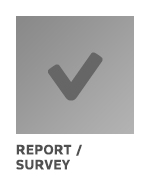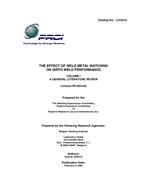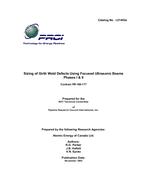Provide PDF Format
PRCI PR-15-423
- Examination of the Kaiser Effect in Pipeline Steels
- Report / Survey by Pipeline Research Council International, 05/01/1985
- Publisher: PRCI
$98.00$195.00
L51492e
Southwest Research Institite
Need: Acoustic emission (AE) proof testing is a particularly attractive method of nondestructively examining large structures such as pressure vessels and pipelines because a total volumetric examination can be made with AE sensors mounted at relatively large intervals over the surface of-the structures. The proof test, to be effective, requires an increase in pressure that is significantly greater than previously applied pressure in order to elicit AE from existing defects. In the case of gas pipelines, however, overpressure of gas in the line represents a considerable risk. It is therefore desirable to develop a means of using AE to examine gas pipelines without excessive overpressure in the line. Even in a flawed structure, AE is significantly reduced or absent during reload to a previously attained stress. This is known as the Kaiser effect. The Kaiser effect is defined in ASTM E610 as "the absence of detectable acoustic emission until previously applied stress levels are exceeded." This quieting of AE during reload is believed to be connected with the reduction of compression yield which accompanies the increase in tensile yield as a result of the Bauschinger effect. This project was undertaken to evaluate the Kaiser effect recovery at several pressurization levels in pipeline steels to minimize over-pressurization during AE proof testing of pipelines.
Result: The experiment to measure the Kaiser recovery was designed so that it would include the major types of defect scenarios and would cover the range of stress levels which a pipeline can experience. The defects, which were included in the tests, included the commonly occurring defects such as fatigue cracks, stress corrosion cracks, and corrosion pits. A specimen without flaws was also included. The effect of stress on the Kaiser recovery was studied by loading the specimens to four levels of stress: 25, 50, 75, and 90 percent of the yield strength of the material. The recovery of the Kaiser effect was measured by loading the sample to the same stress levels at certain intervals of time ranging from 10 minutes to 30 days. These tests were done to measure the acoustic emissions due to loading with an increase in the time during which the Kaiser effect could possibly recover.
Benefit: The tests showed that there was no time-dependent recovery of acoustic emission activity in any group of specimens. However, flawed specimens did produce higher AE activity upon reloading than unflawed specimens. The AE activity from corrosion pits on reload was less than cracks but more than unflawed specimens. It was also demonstrated that a short-term depressurization of a pipe is likely to produce AE activity from flaws upon pressurization. To make use of the conclusions obtained from this program, it is recommended that the AE results be verified on several short pipe specimens in a follow-on program.
Southwest Research Institite
Need: Acoustic emission (AE) proof testing is a particularly attractive method of nondestructively examining large structures such as pressure vessels and pipelines because a total volumetric examination can be made with AE sensors mounted at relatively large intervals over the surface of-the structures. The proof test, to be effective, requires an increase in pressure that is significantly greater than previously applied pressure in order to elicit AE from existing defects. In the case of gas pipelines, however, overpressure of gas in the line represents a considerable risk. It is therefore desirable to develop a means of using AE to examine gas pipelines without excessive overpressure in the line. Even in a flawed structure, AE is significantly reduced or absent during reload to a previously attained stress. This is known as the Kaiser effect. The Kaiser effect is defined in ASTM E610 as "the absence of detectable acoustic emission until previously applied stress levels are exceeded." This quieting of AE during reload is believed to be connected with the reduction of compression yield which accompanies the increase in tensile yield as a result of the Bauschinger effect. This project was undertaken to evaluate the Kaiser effect recovery at several pressurization levels in pipeline steels to minimize over-pressurization during AE proof testing of pipelines.
Result: The experiment to measure the Kaiser recovery was designed so that it would include the major types of defect scenarios and would cover the range of stress levels which a pipeline can experience. The defects, which were included in the tests, included the commonly occurring defects such as fatigue cracks, stress corrosion cracks, and corrosion pits. A specimen without flaws was also included. The effect of stress on the Kaiser recovery was studied by loading the specimens to four levels of stress: 25, 50, 75, and 90 percent of the yield strength of the material. The recovery of the Kaiser effect was measured by loading the sample to the same stress levels at certain intervals of time ranging from 10 minutes to 30 days. These tests were done to measure the acoustic emissions due to loading with an increase in the time during which the Kaiser effect could possibly recover.
Benefit: The tests showed that there was no time-dependent recovery of acoustic emission activity in any group of specimens. However, flawed specimens did produce higher AE activity upon reloading than unflawed specimens. The AE activity from corrosion pits on reload was less than cracks but more than unflawed specimens. It was also demonstrated that a short-term depressurization of a pipe is likely to produce AE activity from flaws upon pressurization. To make use of the conclusions obtained from this program, it is recommended that the AE results be verified on several short pipe specimens in a follow-on program.
Related Products
PRCI PR-328-063502
INVESTIGATIVE FUNDAMENTALS AND PERFOMANCE IMPROVEMENTS OF CURRENT IN-LINE INSPECTION TECHNOLOGIES FO..
$6.00 $12.00




